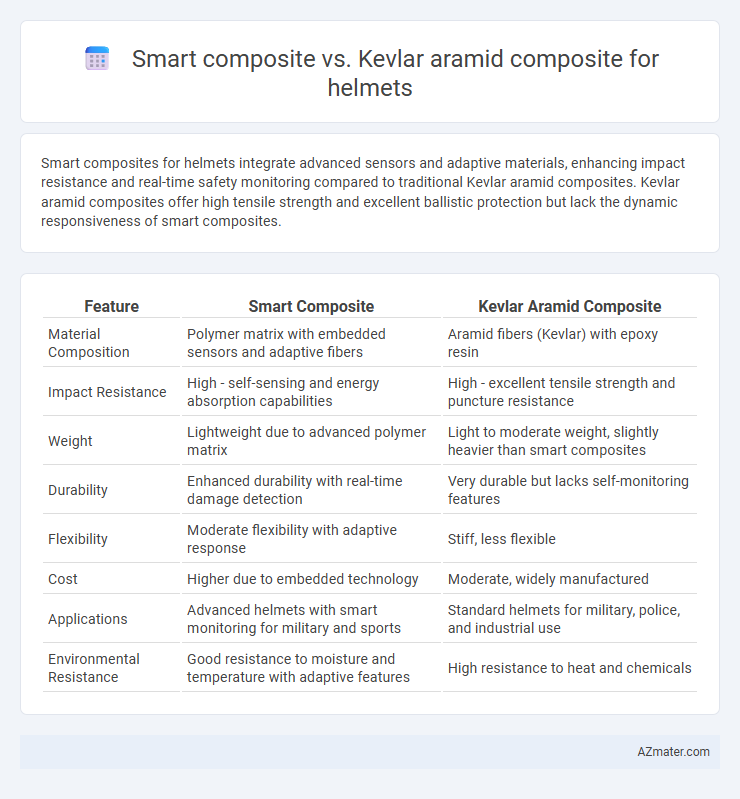Smart composites for helmets integrate advanced sensors and adaptive materials, enhancing impact resistance and real-time safety monitoring compared to traditional Kevlar aramid composites. Kevlar aramid composites offer high tensile strength and excellent ballistic protection but lack the dynamic responsiveness of smart composites.
Table of Comparison
| Feature | Smart Composite | Kevlar Aramid Composite |
|---|---|---|
| Material Composition | Polymer matrix with embedded sensors and adaptive fibers | Aramid fibers (Kevlar) with epoxy resin |
| Impact Resistance | High - self-sensing and energy absorption capabilities | High - excellent tensile strength and puncture resistance |
| Weight | Lightweight due to advanced polymer matrix | Light to moderate weight, slightly heavier than smart composites |
| Durability | Enhanced durability with real-time damage detection | Very durable but lacks self-monitoring features |
| Flexibility | Moderate flexibility with adaptive response | Stiff, less flexible |
| Cost | Higher due to embedded technology | Moderate, widely manufactured |
| Applications | Advanced helmets with smart monitoring for military and sports | Standard helmets for military, police, and industrial use |
| Environmental Resistance | Good resistance to moisture and temperature with adaptive features | High resistance to heat and chemicals |
Introduction to Helmet Materials
Smart composites for helmets incorporate advanced materials with sensors or adaptive properties, enhancing impact absorption and user safety through real-time monitoring. Kevlar aramid composites are renowned for their exceptional tensile strength, lightweight characteristics, and high resistance to ballistic impacts, making them a traditional choice for protective helmets. Both materials offer unique benefits, with smart composites providing dynamic protection and Kevlar aramid composites delivering proven structural durability and reliability in helmet construction.
Overview of Smart Composite Technology
Smart composite technology integrates advanced sensors and adaptive materials within helmet structures to enhance impact resistance and real-time monitoring capabilities, distinguishing it from traditional Kevlar aramid composites known for high tensile strength and lightweight protection. These intelligent materials respond dynamically to external forces, providing superior energy absorption and injury mitigation compared to static Kevlar layers. By embedding smart functionalities such as stress detection and environmental responsiveness, smart composites offer an innovative evolution in helmet safety and performance.
Kevlar Aramid Composite: Properties and Uses
Kevlar aramid composite is widely used in helmet manufacturing for its exceptional strength-to-weight ratio, impact resistance, and thermal stability. This material exhibits high tensile strength, excellent energy absorption, and outstanding resistance to abrasion and chemicals, making it ideal for protective headgear in military, law enforcement, and motorcycling applications. Kevlar's lightweight and durable properties enhance wearer comfort and safety, contributing to superior ballistic protection and long-term helmet performance.
Weight Comparison: Smart Composite vs Kevlar
Smart composites used in helmets typically offer superior weight reduction compared to Kevlar aramid composites, making them ideal for applications where minimizing helmet mass is crucial. Kevlar aramid composites, while providing excellent impact resistance and durability, generally have higher density, resulting in heavier helmets. This weight difference impacts user comfort and fatigue, favoring smart composites for lightweight helmet designs without compromising safety standards.
Impact Resistance and Energy Absorption
Smart composites for helmets integrate advanced materials with embedded sensors that actively dissipate impact energy, offering superior energy absorption compared to traditional Kevlar aramid composites. Kevlar aramid composites provide high tensile strength and durability but lack the adaptive response mechanisms found in smart composites, resulting in comparatively lower impact resistance. The enhanced energy absorption capability of smart composites significantly reduces transmitted forces during collisions, improving overall wearer safety in helmet applications.
Durability and Longevity
Smart composites for helmets leverage advanced polymer matrices combined with nano-reinforcements, significantly enhancing impact resistance and fatigue durability compared to Kevlar aramid composites. Kevlar aramid composites exhibit high tensile strength and excellent resistance to abrasion but may degrade faster under UV exposure and prolonged environmental stress. Smart composites typically offer superior longevity due to improved resistance to environmental factors, maintaining structural integrity over extended service life.
Comfort and Ergonomics
Smart composites in helmets offer superior comfort through adaptive materials that respond to temperature and pressure, reducing localized stress and enhancing ergonomics. Kevlar aramid composites provide excellent impact resistance and durability but can be less flexible, potentially compromising fit and long-term comfort. Integration of smart composites improves ventilation and weight distribution, optimizing helmet ergonomics for extended wear.
Cost Effectiveness and Availability
Smart composites for helmets offer enhanced impact resistance and energy absorption at a moderate cost but face limited availability due to specialized manufacturing processes. Kevlar aramid composites provide a proven balance of high strength, durability, and cost-effectiveness, benefiting from widespread production and established supply chains. Manufacturers prioritize Kevlar composites when optimizing for affordability and consistent material access in helmet production.
Environmental Impact and Sustainability
Smart composites for helmets often incorporate bio-based resins and recyclable fibers, significantly reducing environmental impact compared to traditional Kevlar aramid composites, which rely heavily on petroleum-derived materials and energy-intensive manufacturing processes. The production of Kevlar aramid composites results in higher carbon emissions and non-biodegradable waste, while smart composites enhance sustainability through lower lifecycle emissions and improved end-of-life recyclability. This shift towards smart composites supports eco-friendly helmet manufacturing by minimizing resource depletion and promoting circular economy principles.
Future Trends in Helmet Material Innovation
Smart composites in helmet design integrate sensors and adaptive materials to enhance impact resistance and real-time monitoring, pushing beyond the traditional high-strength Kevlar aramid composites known for their lightweight and ballistic protection. Future trends emphasize the fusion of smart composites with bio-based resins and nanomaterials to improve energy absorption, durability, and environmental sustainability. Advancements in multifunctional helmet materials anticipate increased safety standards and user customization through embedded electronics and responsive layers.

Infographic: Smart composite vs Kevlar aramid composite for Helmet
 azmater.com
azmater.com